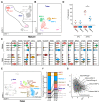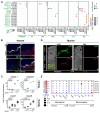Spatiotemporal immune zonation of the human kidney
- PMID: 31604275
- PMCID: PMC7343525
- DOI: 10.1126/science.aat5031
Spatiotemporal immune zonation of the human kidney
Abstract
Tissue-resident immune cells are important for organ homeostasis and defense. The epithelium may contribute to these functions directly or by cross-talk with immune cells. We used single-cell RNA sequencing to resolve the spatiotemporal immune topology of the human kidney. We reveal anatomically defined expression patterns of immune genes within the epithelial compartment, with antimicrobial peptide transcripts evident in pelvic epithelium in the mature, but not fetal, kidney. A network of tissue-resident myeloid and lymphoid immune cells was evident in both fetal and mature kidney, with postnatal acquisition of transcriptional programs that promote infection-defense capabilities. Epithelial-immune cross-talk orchestrated localization of antibacterial macrophages and neutrophils to the regions of the kidney most susceptible to infection. Overall, our study provides a global overview of how the immune landscape of the human kidney is zonated to counter the dominant immunological challenge.
Copyright © 2019 The Authors, some rights reserved; exclusive licensee American Association for the Advancement of Science. No claim to original U.S. Government Works.
Conflict of interest statement
Figures




Comment in
-
Immune topology of the human kidney.Nat Rev Nephrol. 2019 Dec;15(12):729. doi: 10.1038/s41581-019-0223-7. Nat Rev Nephrol. 2019. PMID: 31619773 No abstract available.
-
Drawing a single-cell landscape of the human kidney in (pseudo)-space and time.Kidney Int. 2020 May;97(5):842-844. doi: 10.1016/j.kint.2020.01.011. Kidney Int. 2020. PMID: 32331591 No abstract available.
References
-
- Kurts C, Panzer U, Anders HJ, Rees AJ. The immune system and kidney disease: basic concepts and clinical implications. Nat Rev Immunol. 2013;13:738–753. - PubMed
-
- Giebisch G. Coupled ion and fluid transport in the kidney. N Engl J Med. 1972;287:913–919. - PubMed
-
- Berry MR, et al. Renal Sodium Gradient Orchestrates a Dynamic Antibacterial Defense Zone. Cell. 2017;170:860–874 e819. - PubMed
Publication types
MeSH terms
Grants and funding
LinkOut - more resources
Full Text Sources
Other Literature Sources

